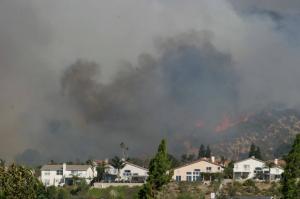CHIANG MAI, THAILAND, July 9, 2024 /EINPresswire.com/ — Amid the escalating wildfire crises in the United States, new research highlights the alarming toxicity of wildfire smoke, revealing it to be potentially ten times more harmful than traffic pollution. As wildfires ravage parts of California, Oregon, and Washington, affecting air quality across the nation, the urgency to address the severe health impacts of wildfire smoke has never been greater. Studies indicate that wildfire smoke’s impact on respiratory health is significantly more severe compared to urban air pollution, emphasizing the need for heightened awareness and advanced air quality monitoring solutions.
“Wildfire smoke is an issue close to our hearts,” said Achim Haug, CEO and Founder of AirGradient. “Our commitment to air quality monitoring was born from the urgent need to measure the air quality during the 2019 Chiang Mai wildfires. Witnessing firsthand the severe impact of wildfire smoke, we dedicated ourselves to providing accessible and reliable air quality solutions.”
In 2020, the United States experienced widespread air quality degradation as smoke from West Coast wildfires traveled across the country, reaching as far as New York City and Europe. The 2023 wildfire season in Canada marked the most intense on record, further underscoring the escalating threat. Wildfire smoke is not confined to fire-prone regions; it can disperse over vast distances, affecting air quality and public health far from the fire source.
Why Is Wildfire Smoke So Dangerous?
Wildfire smoke is a complex mixture of gases, chemicals, and fine particles from burning trees, shrubs, buildings, and vehicles. Unlike smoke from cooking or traffic, which contains volatile organic compounds (VOCs) from burning food and oil or nitrogen oxides (NOx) and particulate matter from the combustion of fossil fuels, wildfire smoke is highly toxic due to its diverse and unpredictable composition. Research published in Nature Communications Journal found that wildfire smoke causes more significant health impacts than other urban air pollution sources. This underscores the severe and unique dangers posed by wildfire smoke.
Wildfire smoke is a complex mixture of gasses and fine particles that can harm human health. At its core, wildfire smoke contains many of the same pollutants found in normal smoke but at much higher concentrations. According to a study published in theJournal of Environmental Science & Technology, this includes carbon dioxide, carbon monoxide, methane, volatile organic compounds (VOCs) like formaldehyde and acrolein, nitrogen oxides, polycyclic aromatic hydrocarbons (PAHs), and organic compounds such as levoglucosan. The unique and high concentrations of these pollutants, combined with the combustion of various materials like cars and houses during wildfires, create a dangerously potent ‘cocktail’ of gasses and particles. Notably, PM2.5 particles in wildfire smoke are particularly hazardous due to their composition and size, which makes them more harmful than PM2.5 from other sources.
According to Research published in the Indian Journal of Clinical Biochemistry, the high carbon content of wildfire PM2.5 includes a significant amount of free radicals and reactive oxygen species (ROS), which cause oxidative stress by attacking cell components such as lipids, proteins, and DNA. This leads to various health issues, including inflammation, lung damage, and an increased risk of cancer. Additionally, wildfire smoke contains heavy metals like lead and zinc, which further catalyze the formation of ROS, intensifying oxidative stress and inflammation. These particles can penetrate deep into the lungs, adhering more strongly and causing long-term damage. The organic coatings on wildfire PM2.5 enhance their bioavailability, allowing toxic compounds to be more readily absorbed by cells and tissues, thus posing greater health risks.
Accurate air quality monitoring is essential in addressing the harmful effects of wildfire smoke. By providing real-time data, air quality monitors enable communities and individuals to make informed decisions to protect their health. These monitors measure key pollutants, including PM2.5, VOCs, and other harmful compounds found in wildfire smoke, helping users identify high-risk periods and take necessary precautions.
AirGradient’s open-source approach allows communities to build and deploy their own air quality monitoring networks, ensuring widespread access to reliable air quality data. This empowers individuals, schools, businesses, and governments to respond effectively to wildfire smoke and mitigate its impact on public health. Additionally, collaboration with environmental organizations and research institutions enhances the understanding of wildfire smoke and supports efforts to reduce exposure and improve air quality.
About AirGradient
AirGradient is a pioneer of accurate, open-source air quality monitoring solutions for indoor and outdoor environments. Driven by a passion for cleaner air and environmental responsibility, AirGradient provides affordable and accessible air quality monitors to thousands of users in over 75 countries. AirGradient is committed to empowering people to take control of their air quality and making a positive impact on the global environment. The company’s open-source hardware and software platform enables users to build, customize, and deploy their own air quality monitors. AirGradient also partners with openAQ, more than 25 research partners from leading institutions and universities, along with environmental organizations to advance air quality science and advocacy. AirGradient is also a member of the 1% for the Planet movement and donates 1% of sales to environmental protection organizations.
For more information, interviews, or media inquiries, please contact:
Yohana Angeline | Communications and Community Engagement Manager | AirGradient | [email protected]
Yohana Angeline
Airgradient Limited
+62 815-1711-8025
email us here
![]()
Originally published at https://www.einpresswire.com/article/723378735/wildfire-smoke-far-more-dangerous-than-previously-thought-potentially-10x-more-toxic-than-traffic-smoke





